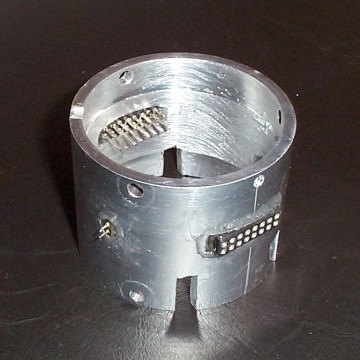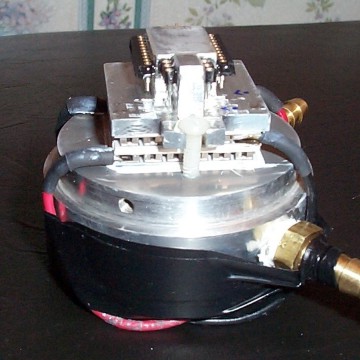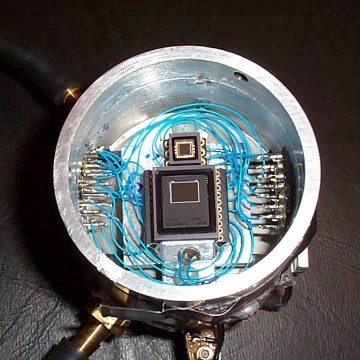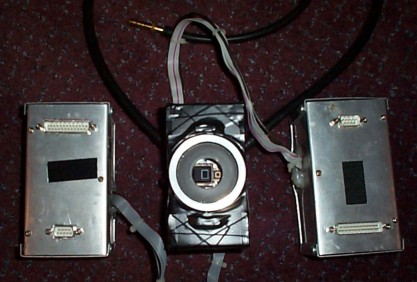
Converting Cookbook CCD camera into "self-guiding" instrument
Since 1997 I have been using Cookbook 245 camera on Celestron Ultima 8 Schmidt-Cassegrain scope. I did realize quite quickly than its drive imposes serious limitations. Quick track-and-stack approach involving a number of 60 sec. exposures worked well with telescope equiped with Celestron f6.3 reducer, though about 1/4 of images had to be discarded due to "trailing". Switching to f3.0 focal reducer (mainly for mosaic work) resulted in practically all 60 sec. exposure being acceptable.
After about a year of initial use, I decided to construct Cookbook 211 to serve as autoguider. That second camera was attached to the small scope strapped to the main instrument - most recently I have used a variant of tangent mount. This facilitated efficient search for a guide star within relatively large area surrounding main target. Use of an autoguider allowed significantly longer exposures (up to 15 min., though 4 min. was most frequently used) and resulting images had a lot better signal-to-noise ratio. However, flexture of tangent arm mount caused slightly oval star images sometimes.
To cure that, I have decided to put guiding chip inside imaging camera body. A quick check of inside dimensions of Cookbook camera housing showed that there is enough room there. Below is a short description of main modifications I went through:
I disassembled both cameras, taking ESD precoutions of course (especially with CCD chips) and removed all wires attached to J2/J3 socket of Cookbook 245 body. Cold finger was removed from it as well.
My friend Fred Barret from Kingston RASC Centre milled a modified cold finger. It has wider area to mount TC245 CCD (with detector area centered on optical axis) and a smaller, offset area to mount TC211 CCD. TC211 mounting surface was raised 0.5 mm as well. Then 3-pin standard and 10-pin 1mm-spaced socket strips (two each) were glued to both sides of cold finger to accomodate detectors (see image below for details). A small teristor probe from car termometer was glued as well into a small hole drilled in the side of cold finger.
I cut additional slot for J2/J3 connector on the opposite side of camera body and glued the connector into it.




and the rest of the parts was assmebled.

My modified 245/211 CCD camera has one body but everyting else is double. Two computers are needed of course Both rum CBWinCam as acqusition/guiding software. To image anything I follow a few steps:
Turn on computers, pump and camera power supply, then gradually cool detectors to about -30°C.
Point camera toward deep sky target, focus and center its image on TC245 detector.
Check in Guide for the location of a potential guide star 10 to 30 arcmin. away (depending on focal ration used - f10, f6.3 or f3.0).
Slowly rotate camera housing to proper orientation until guide star is displayed in the image obtained by TC211 detector in "Find" mode.
Adjust position of the guide star on TC211 chip and deep sky target on imaging TC245 chip (try to keep it close to the center).
Switch TC211 to "SuperFocus" mode, find shortest exposure giving high SNR and calibrate autoguider.
Start autoguiding and check if telescope follows guide star reliably. If not, repeat calibration and increase integration time if necessary.
Start integrating images of deep sky target.
Prior to imaging next target, take flat frames because camera will need to be rotated to find guide star to guide.
At the end of imaging run, take set of dark frames.
Of course, taking flat frames after each object may seem like a hasle - however it does not take long if light box is used. Having imaging and guiding chips in the same camera body completely eliminates differential flexture of separate guide scope and mirror flop, so common in SCTs. Because guide star is registered trough larger telescope now, I can guide on fainter stars. Even at f10, star images are round in longer exposures - see NGC6217 for example.
Number of visitors:
© Jan Wisniewski